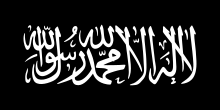Symbols of Islam

Symbols of Islam are symbols of various kinds that have acquired a special reference to Islam through certain historical events, oral or written traditions and linguistic similarities . These symbols include Arabic calligraphy of significant concepts or phrases, such as the Shahada , the Takbir, or the Basmala . In addition, the color green is often used to symbolize Islam. The star and crescent were the emblems of the Ottoman Empire in the 19th century and were increasingly associated with Orientalism at the end of the 19th century .
Colours
The early Islamic armies and caravans carried single-colored flags, usually black or white, for identification purposes. Later on, Muslim leaders used a simple black, white, or green flag with no markings, writing, or symbolism on it. Mohammed used flags in several colors in various Ghazwat , the campaigns he led himself, and the Saraya , the campaigns of the Sahaba , his companions. Muhammad's main flag, the Black Banner, came to be known as al-qUqāb ("Eagle"). It was pure black with no symbols or markings. The name and color came from the flag of the Quraish , one of the tribes of Arabia , which was black and marked with an eagle.
- The Umayyads fought under green and gold banners.
- The Abbasids voted black (or blue) and fought under black banners.
- The Fatimids used a green standard and white with gold.
- Several countries in the Persian Gulf have red flags.
These four pan-Arab colors (white, black, green and red) dominate the flags of the Arab states.
The brown color is often associated with purity and peace. Many Muslims wear the white color for Friday prayers. Black is the color of mourning in the west and in the Mediterranean. However, in some Muslim cultures it is considered the color of modesty. It is often worn by Shiite Muslims who mourn Husain ibn Ali who was killed in the battle of Karbala . It is the color of the chador of pious Shiite women in Iran and the cloaks of the Ayatollahs , the Shiite clergy. In many Shiite countries, a black turban is worn by male Sayyids , men who are descended from Mohammed through his daughter Fatima and his son-in-law Ali. In the Sunni tradition, Mohammed wore a white kufi, a cap, with a black amaana (turban).
Labeled flags

Religious flags with inscriptions such as those depicted by the illustrator Yahya ibn Mahmud al-Wasiti in the 13th century appeared in the Middle Ages. The story of the Tatars from Hethum of Korykos (1243) depicts both Mongols and Seljuks with a number of war regalia.
A Zulfikar flag of Sultan Selim I is displayed in the Topkapı Palace . Two Zulfikar flags are also depicted on an engraving by Bernard Picart in Cérémonies et coutumes religieuses de tous les peuples du monde (1737) about the Janissaries and Sipahis .
Star and crescent
The symbolism of the star and crescent was strongly associated with the Ottoman Empire in the 19th century . The symbol was used throughout the Middle East in pre-Islamic times, particularly in the Byzantine Empire and the Crusader states , which ruled areas that later became Ottoman. Through its use in the Ottoman Empire, it also became a symbol for Islam as a whole and also stood for Western Orientalism . “Star and Crescent” served as a metaphor for the rule of Islamic empires such as the Ottoman Empire and Persia in British literature of the late 19th century. This association was reinforced by the increasing spread of stars and crescents in the decorations of Ottoman mosques and minarets. The emblem of the red crescent was used by the International Committee of the Red Cross (ICRC) as early as 1877 in the Russo-Turkish War . It was officially introduced in 1929.
After the fall of the Ottoman Empire in 1922, the star and the crescent became part of the national flag in several successor states. In the flag of the Kingdom of Libya (1951) they were explicitly given an Islamic interpretation, in which they were linked to the "story of the hijra of the Prophet Mohammed". In the 1950s, symbolism was adopted by Arab nationalists or Islamists , such as the planned Arab Islamic Republic (1974) and the US organization Nation of Islam (1973).
See also
Web links
Individual evidence
- ↑ Islamic flags ( Memento of the original from June 10, 2007 in the Internet Archive ) Info: The archive link was inserted automatically and has not yet been checked. Please check the original and archive link according to the instructions and then remove this notice.
- ^ Saudi Aramco World. Flags of the Arab World ( Memento of the original dated November 14, 2005 in the Internet Archive ) Info: The archive link was inserted automatically and has not yet been checked. Please check the original and archive link according to the instructions and then remove this notice.
- ↑ Ottoman Empire: Flags and coats of arms shown in the Topkapi Museum (Istanbul)
- ↑ eg
- ↑ "Mosque and minaret are surounted by crescents; the air glowing over the Golden Horn is, as it were, full of moons."
- ↑ The symbolism of the star and crescent in the flag of the Kingdom of Libya (1951-1969) was explained in an English language booklet, The Libyan Flag & The National Anthem , issued by the Ministry of Information and Guidance of the Kingdom of Libya (year unknown, cited after Jos Poels at FOTW , 1997) as follows: "The crescent is symbolic of the beginning of the lunar month according to the Muslim calendar."
- ↑ Edward E. Curtis: Black Muslim religion in the Nation of Islam, 1960-1975. 2006, p. 157 books.google.com .

